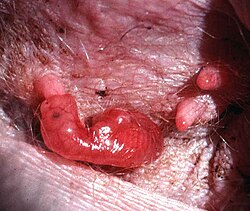|
|
| (10 intermediate revisions by the same user not shown) |
| Line 1: |
Line 1: |
| − | {{Taxobox begin | color = pink | name = Pademelon}}
| + | [[Image:Joey in pouch.jpg|right|thumb|180px|Kangaroo Joey inside the pouch]] |
| − | {{Taxobox image | image = [[image:pademelon.jpg|200px]] | caption = }}
| + | The '''pouch''' is a distinguishing feature of [[marsupial]]s; the name marsupial is derived from the Latin '''marsupium''', meaning pouch. Marsupials give birth to a live but relatively undeveloped [[fetus]] called a [[Joey (marsupial)|Joey]]. When the Joey is born it crawls from the vagina to the pouch. The pouch is basically a fold of skin with a single opening that covers the [[nipple]]s to protect the Joey as it continues to develop. |
| − | {{Taxobox begin placement | color = pink}}
| |
| − | {{Taxobox regnum entry | taxon = [[Animal]]ia}}
| |
| − | {{Taxobox subregnum entry | taxon = [[Chordata]]}}
| |
| − | {{Taxobox classis entry | taxon = [[Mammal]]ia}}
| |
| − | {{Taxobox ordo entry | taxon = [[Diprotodontia]]}}
| |
| − | {{Taxobox familia entry | taxon = [[Macropodidae]]}}
| |
| − | {{Taxobox genus entry | taxon = '''''Thylogale'''''}}
| |
| − | {{Taxobox end placement}}
| |
| − | {{Taxobox end}}
| |
| | | | |
| − | A '''pademelon''' is any of four species of small, kangaroo-like creatures that are usually found in forests. Pademelons are the smallest of the [[macropod]]s.
| + | Pouches are different amongst the different marsupials: for example the [[Tasmanian Devil]]'s pouch opens to the rear and the Joey only has to travel a short distance to get to the opening of the pouch, while in the pouch they are permanently attached to the nipple and once the young have developed they leave the pouch and do not return. The [[kangaroo]]'s opens horizontally on the front of the body, and the Joey must climb a relatively long way to reach it. Kangaroos and [[wallaby|wallabies]] allow their young to live in the pouch well after they are physically capable of leaving. |
| | | | |
| − | Pademelons, [[wallaby|wallabies]], and [[kangaroo]]s are all very alike in body structure, and the names just refer to the three different size groups. Originally wallabies were divided into small and large wallabies, but a more suitable name was needed to differentiate between them. The word "pademelon" is probably a corruption of their aboriginal name.
| + | [[category:Marsupials]] |
| − | | |
| − | Besides their smaller size, pademelons can be distinguished from wallabies by their shorter, thicker, and sparsely haired tails.
| |
| − | | |
| − | ==Distribution and habitat==
| |
| − | | |
| − | [[Red-necked Pademelon]]s can be found in the coastal regions of [[Queensland]] and [[New South Wales]]. In some places their range has been drastically reduced. [[Red-legged Pademelon]]s can also be found in south-central [[New Guinea]]. The Red-bellied or Tasmanian Pademelon is abundant in [[Tasmania]]. The Dusky Pademelon lives in [[Papua New Guinea]] and surrounding islands.
| |
| − | | |
| − | The natural habitat of the pademelon is in thick scrubland or dense forested undergrowth. They also make tunnels through long grasses and bushes in swampy country.
| |
| − | | |
| − | ==Diet and behavior==
| |
| − | | |
| − | If there are no predators, such as dogs, they graze in the early mornings or evenings on grassy slopes near thickets, into which they can quickly escape at the first sign of danger. Pademelons are nocturnal and feed at night.
| |
| − | | |
| − | Their main diet is made up of grasses, leaves, and small shoots. They do little damage to crops and are not as aggressive as wallabies and kangaroos can be, making them gentle pets.
| |
| − | | |
| − | Tasmanian Pademelons were important to the [[Thylacine]]'s diet, and are still preyed on by [[quoll]]s, [[Tasmanian Devil]]s, and [[Wedge-tailed Eagle]]s. Despite these predators, there are many in Tasmania and every year some are killed off to keep their numbers down.
| |
| − | | |
| − | ==Problems faced==
| |
| − | | |
| − | Pademelon meat used to be considered valuable, and was eaten by settlers and aborigines for a long time. It was once even suggested that they be introduced to France as a meat supply. However, pademelons, like all kangaroos, are slow breeders and almost always produce one young per year, meaning it would be difficult to raise enough to use for food.
| |
| − | | |
| − | Aside from being killed for their meat and soft fur, their numbers have been reduced by the introduction of predators such as feral cats, dogs, and foxes. The [[rabbit (ecology)|rabbit]] explosion has also caused problems, as rabbits graze on the same grasses making less available for the pademelon. Also, people clearing the land to make room for homes has pushed the larger wallabies and kangaroos into the land that the pademelons had been thriving in for so long.
| |
| − | | |
| − | ==Conservation status==
| |
| − | | |
| − | * [[Red-legged Pademelon]] (''Thylogale stigmatica'') - vulnerable
| |
| − | * [[Red-necked Pademelon]] (''Thylogale thetis'') - common
| |
| − | * [[Dusky Pademelon]] (''Thylogale brunii'') - vulnerable
| |
| − | * Tasmanian or [[Red-bellied Pademelon]] (''Thylogale billardierii'') - partially protected
| |
| − | | |
| − | [[de:Filander]]
| |
| − | [[ja:ヤブワラビー属]]
| |
| − | [[Category:Australian animals]]
| |

